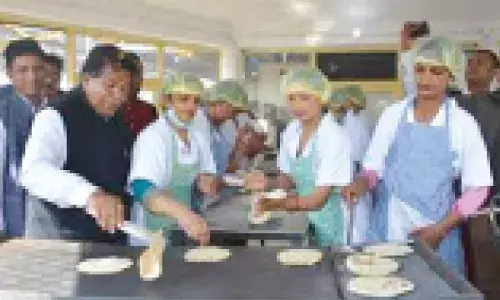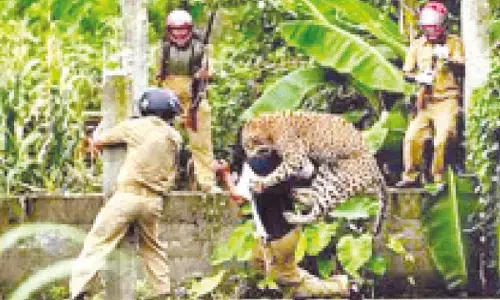Preserve cultural heritage for future generations

Preserve Cultural Heritage For Future Generations. During January, newspapers and TV channels, professional colleges as well as schools were trying to do their best to showcase our Telugu Culture and heritage regarding the celebration of Sankranti.
According to the Oriental Department of the German National Library (Berlin), there is a minimum of 1 million such palm-leaf books. Our awesome heritage is materially, physically falling apart at an absolutely alarming rate. German scientists have determined that most Indian palm-leaf books will naturally decay within the next 50 to 100 years. It is the digital revolution that can turn the tables on the destructive powers of time.
.jpg) During January, newspapers and TV channels, professional colleges as well as schools were trying to do their best to showcase our Telugu Culture and heritage regarding the celebration of Sankranti. I was rather melancholic seeing all the attempts, including the affected Telugu being spoken, because, for any culture to live and survive, it has to be a part of our life, an indivisible programme infused into our systems , something inseparable from our normal lives, either for religious or social reasons. Once it becomes a show piece, its days are numbered.
During January, newspapers and TV channels, professional colleges as well as schools were trying to do their best to showcase our Telugu Culture and heritage regarding the celebration of Sankranti. I was rather melancholic seeing all the attempts, including the affected Telugu being spoken, because, for any culture to live and survive, it has to be a part of our life, an indivisible programme infused into our systems , something inseparable from our normal lives, either for religious or social reasons. Once it becomes a show piece, its days are numbered.
The current generation of youngsters may parrot some Telugu folk songs or verses, may don the traditional Telugu attire like in a fashion parade on that particular day but they may never know the true origin of the actions, the beliefs underlying them nor how centuries of our ancestors felt blessed for knowing the significance of the deeds now being showcased. They are indeed sad times when a nation’s rich heritage goes neglected and generations become indifferent to their noble past and its glory. For what are we without our roots? My recent visit to Badhankurthi, an island on the river Godavari between Karimnagar, Nizamabad and Adilabad districts made me think further on these lines.
One of the threats from global culture is the increased chances of wiping out of the local cultures. Unity does not mean uniformity and the world will be a richer place only when every region protects and upholds its unique wealth of knowledge, subtle and refined habits or customs, expressions, art, architecture and culture which are specific to that soil. When I come to think of this, of all the nations in the world, we can be proud of being the home to one of the most ancient civilisations, languages, philosophy and the cradle of human culture even when the rest of the world was woefully childish. Since millennia it has been one of the main contributors of achievements in fields as diverse as medicine, mathematics, the sciences, technology, philosophy, theology, literature, linguistics, not to forget the graphic arts, music, dance and innumerable other disciplines.This only means that we have a vast wealth to preserve, to protect and pass on to our future. Any negligence in this regard would be highly unbecoming of a knowledge society member and much more so for a nation with the potential to be knowledge super power.
Our Telugu-speaking people’s zeal to learn English may or may not have yielded adequate results but it certainly has ruined their native accent and ability of expression in Telugu! In 2008, the Central Government has conferred the status of an ‘Ancient Language’ on Telugu, considering it to come after Sanskrit and Tamil which are 5,000 and 3,000 years old in our country. Recently Telugu inscriptions which are nearly 4,500 years old have been unearthed! It is in the top 15 languages spoken around the world and is the sweetest language of India, nicknamed the "Italian of the East" as 95 per cent of Telugu words end with a vowel giving a sweet effect. Local or regional dialects are the springs of synonyms, lending a wealth of vocabulary, idioms and proverbs bringing richness to any language. Many of them may not have entered the printed form too. Our research should identify such pockets and preserve them. The Telugu language used in Sri Annamacharya Kirthanas would be difficult for us to understand and appreciate had not scholarly work been done in that direction. My contention is that our social sciences, life sciences and their research should be more vibrant and creative in using technology to immortalise our fast-fading relics of literary heritage, be it in Telugu or otherwise. If ‘Heritage’, encompasses tangible and intangible, natural and cultural, movable and immovable and documentary assets inherited from the past and transmitted to future generations by virtue of their irreplaceable value, is not our ancient Telugu deserving of all care?
One of the main forms of Indian literary heritage is the palm-leaf book. Much of India’s written heritage has been passed on in the form of specially treated palm leaves, with writing in ink or engraving. The amount of books on all kinds of subjects which India has produced using this medium is absolutely amazing. According to a conservative estimate by the Oriental Department of the German National Library (Berlin), there is a minimum of 1 million such palm-leaf books, most of them unpublished. The production of the entire rest of the world together is only around 10 million books. Our awesome heritage is materially, physically falling apart at an absolutely alarming rate. German scientists have determined that most Indian palm-leaf books will naturally decay within the next 50 to 100 years. It is the digital revolution that can turn the tables on the destructive powers of time. All is not lost yet, for there are many unsung scholars in our remote hamlets who treasure their family heirlooms. We must hasten to identify them and digitalise the scripts for the future generations.
When we talk of Buddhism in AP, Nagarjuna Sagar and Amaravthi come to our minds. But there are so many other historically significant spots which our archeologists have overlooked so far. Natural and cultural heritage sites, museums, libraries and archive collections around the world are increasingly becoming the collateral victims of natural disasters and armed conflicts. The upsurge in wilful destruction of heritage, whether in Afghanistan, the Middle East or Africa over the past decade is driving the UNESCO in leading international efforts to prevent the pillage and illicit trafficking of cultural property. But what if we do not even know, do not even acknowledge that we have such treasures? I just cite the case of Badhankurthi, mentioned in ‘Suttanipatha’ as the first spot where Buddhism sprouted in Andhra Pradesh. Historians have ascertained that apart from the places visited by the Buddha himself, Badhankurthi is the first place to welcome and embrace Buddhism through the Rishi Bavari. Sixteen of his disciples travelled all the way to Vaisali to get their doubts clarified and accepted Buddhism while one of them returned to Badhankurthi and convey Buddha’s preaching to his aged master Bavari, who then got convinced and turned to Buddhism. There are some relics in a highly neglected and dilapidated condition here and I sincerely feel that we must do our best to safeguard our past glory to preserve our unique identity. While some advanced nations feel poor as they have no sound history to own and boast, we seem to be blind to our wealth!
A few months back I shared my experiences of visiting remote villages around Basara along with some school children who were out to spot all things strange and wonderful there. If our local schools can take up such pilot projects, may be it would be doing a lot of ground work while developing critical thinking and observation skills in the young minds.
The importance of preserving our own cultural heritage escalates with each passing decade. As time goes on and people move from one country to the next or become too busy to reflect on their roots, the more it is at risk for endangerment. It is our responsibility to keep world history intact for tomorrow’s children so that they may have the same opportunities to learn about the past and their own roots as we have.
(The writer is a notededucationist and former MLC)














